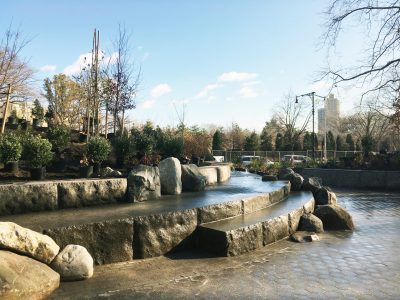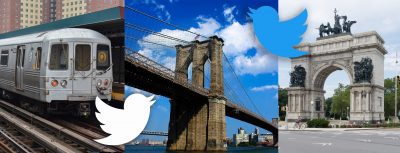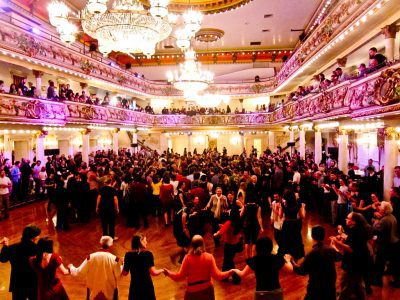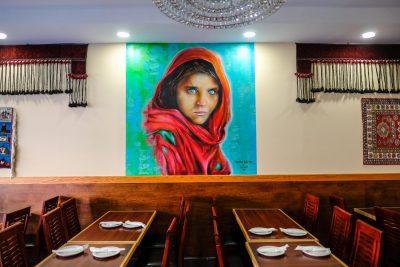NYRP kicked off 2024’s free tree giveaway in Travers Park, Queens, last Saturday (Photo by Arielle Domb)
How to get a free tree of your own for Earth Day
New York Restoration Project is tackling urban inequity by giving New Yorkers free trees to plant in all five boroughs
It’s 10 a.m. on a wet, windy Saturday morning and a cluster of New Yorkers have gathered under a pop-up canopy tent in Travers Park, Queens. Clutching umbrellas and paper cups of coffees, they take turns flipping through a laminated menu of sorts, ruminating over an important question: What type of tree would they like to take home? An elderberry? A Northern red oak? An American persimmon? A sweetbay magnolia?
Thanks to New York Restoration Project (NYRP), New Yorkers can register online to receive a free tree this spring, a scheme that has distributed over 75,000 trees across all five boroughs since its launch in 2008. Brooklynites can get one of their own from one of eight different locations starting April 20.
If anyone is expecting a fully grown tree, however, they’d be disappointed. Most trees being handed out are meager shoots and sprouts. The idea is that participants take their sapling home and plant them, reassured that with the right care, they can grow as tall as 50 feet.

Queens locals brave the rain for a free sapling (Photo by Arielle Domb)
For Helena Koffigoh, a recent college graduate, the process of tending to her plants is one of the best parts of having them. “It gives me more of a routine to stick to,” she says, her orange sparkle-painted nails clutching her new potted tree. “Something else to take care of other than myself.”
New York City is home to more than 7 million trees, which — although might sound like a lot — amounts to fewer than one tree per resident. Trees are unevenly distributed, concentrated in affluent neighborhoods and lacking in areas housing low-income residents and people of color.
These inequities have far-reaching health ramifications. In the United States, racial and ethnic minorities breathe in more harmful particles than their white counterparts. Trees are one way to reduce air pollution, creating clean air and healthier lungs.
“Trees are infrastructure,” says Mike Horwitz, the public programming coordinator for NYRP who is co-running today’s giveaway. “When we think of infrastructure, typically we think of highways, sewers, man made stuff essentially. However, trees perform a lot of the same functions that those structures do in our built environment.”
Around 350 New Yorkers die each summer from heat-related causes. Without drastic action, this figure will likely rise. According to the Urban Climate Lab, planting trees along sidewalks is the most efficient way to protect residents against extreme heat — providing shade and cooling street temperatures through evapotranspiration. Trees also mitigate stormwater floods and create wildlife habitats, increasing biodiversity.
As well as helping combat the effects of climate change, planting trees has a plethora of mental health benefits. Being around nature, even for just a few minutes, will reduce blood pressure, build a stronger immune system and lower stress levels. A student looking out of their classroom onto a green landscape will do better in exams. A hospital patient who can see leafy trees from their window will recover faster.
Horitz is warmed to see people return to the tree giveaways each year, playing a part in creating a more resilient city. “That tells me that they are probably still living in the same location, caring for the trees we previously gave them,” he said.
“It’s very therapeutic,” says Katherine Ramirez, who has picked up a magnolia tree, adding to her collection of thriving trees she’s accumulated from previous NYRP giveaways. “When you’re living in a busy city, there’s work, stress, chaos, construction going on everywhere.” Gardening is a moment of mindfulness and rejuvenation, particularly when living in an urban environment. “You’re giving back to nature,” Ramirez says.


Locals return to the giveaway each year, to receive new trees (Photo by Arielle Domb)
Several recipients are drawn to the culinary aspects of tree-planting. Magnolia petals can be pickled (they taste like ginger, apparently) and elderberries, packed with antioxidants, can be cooked up into syrups, liquors and jams (without cooking, however, they are mildly poisonous). “It’s like a circle,” says Joyce Artis, a passionate urban ecology advocate. “We feed them. They feed us.”
Artis has contributed to a number of gardening projects throughout the city, from helping to plant bulbs with the Daffodil Project to growing fruit and vegetables in the rooftop farm of her Long Island City apartment. Today, she’s adding a flowering dogwood and elderberry tree to her garden. “Even though you don’t see them regularly, [these trees] are native to New York,” she says, “They just disappear due to construction. Trees are ripped out to build buildings and parking lots.”
By 11 a.m., the drizzling has intensified. A dance group has appeared beside the tree giveaway tent, busting moves to pumping music, despite the rain. I ask Artis why she decided to come to the giveaway, spending her Saturday morning in inclement weather.
“We’re New Yorkers,” she says, “We have to replenish the earth” — “Trees are one way of doing that.”
Starting April 20, trees will be given away from eight different Brooklyn locations, including Carnasie, Sunset Park, Red Hook and Brownsville. Register here to pick one up.
You might also like 

























